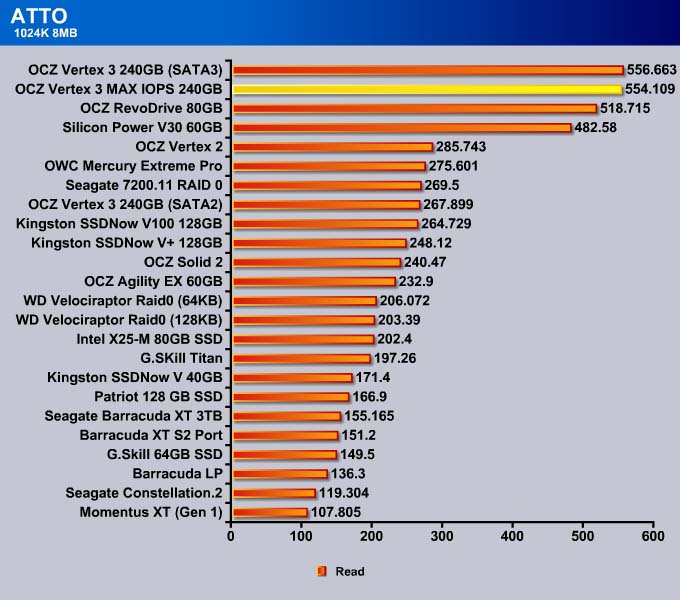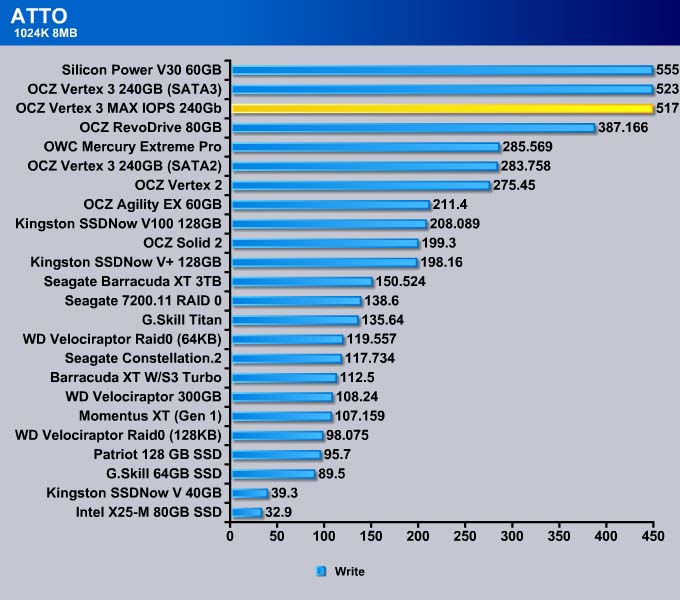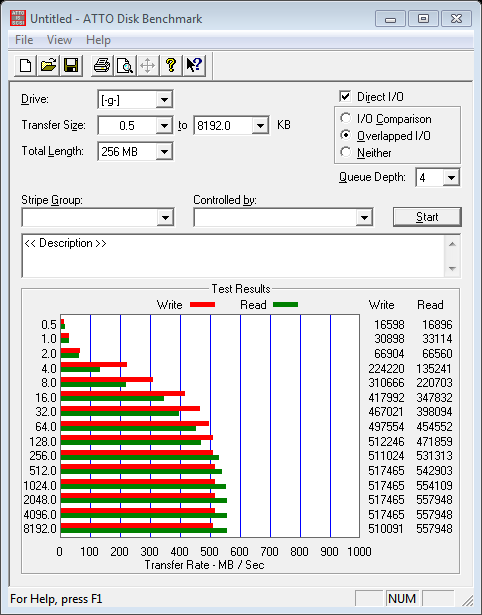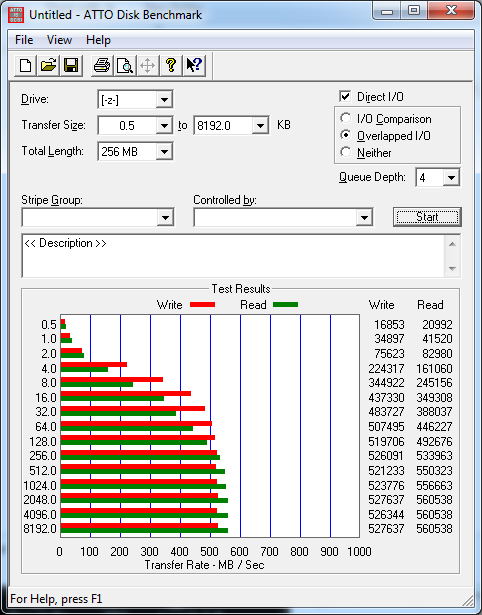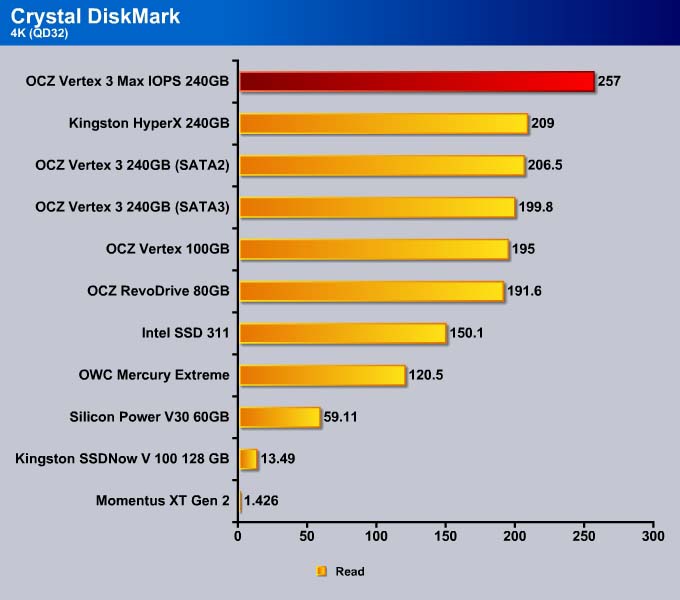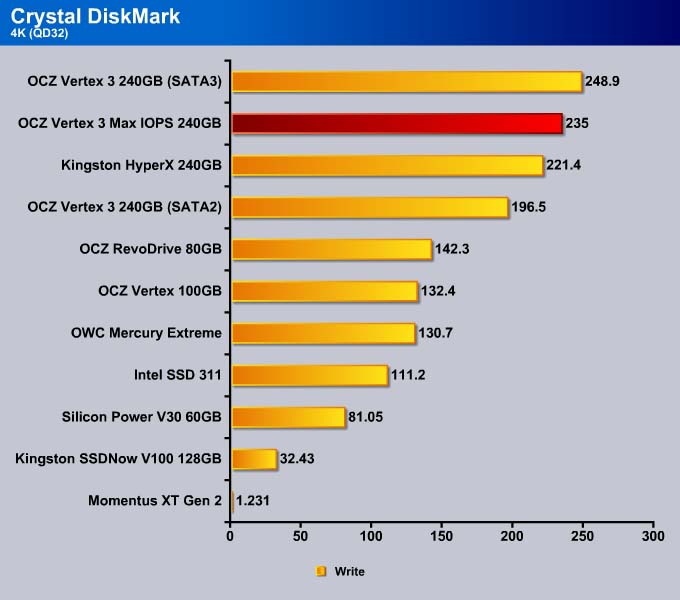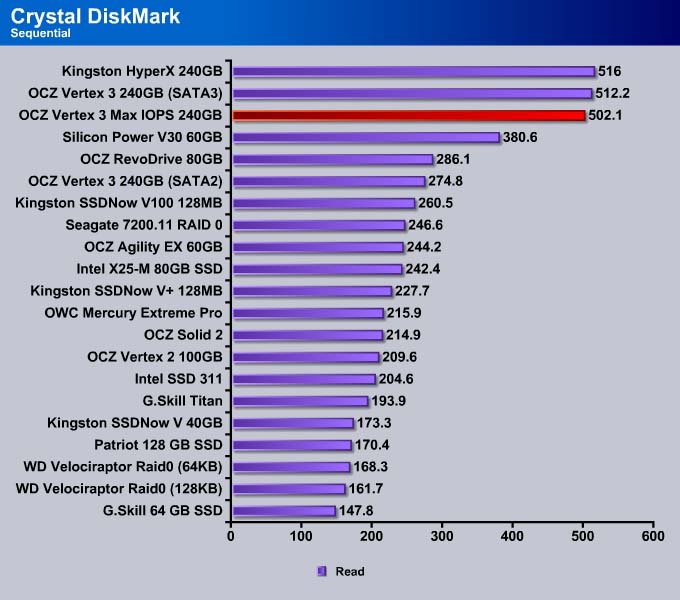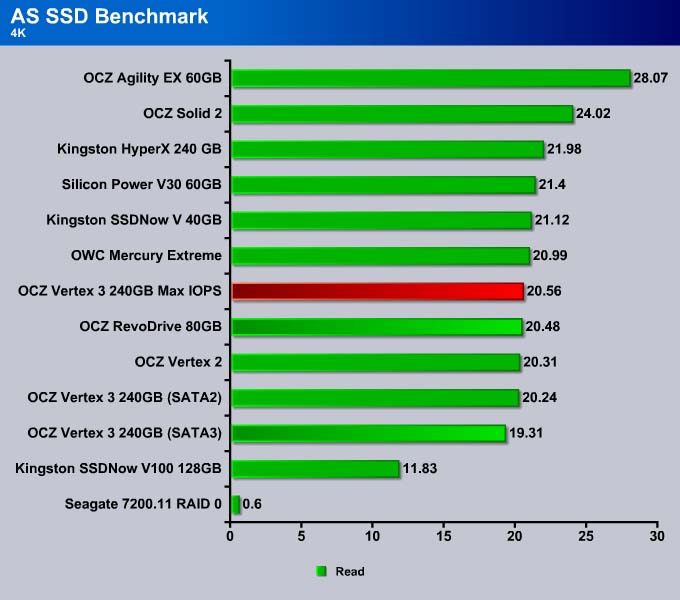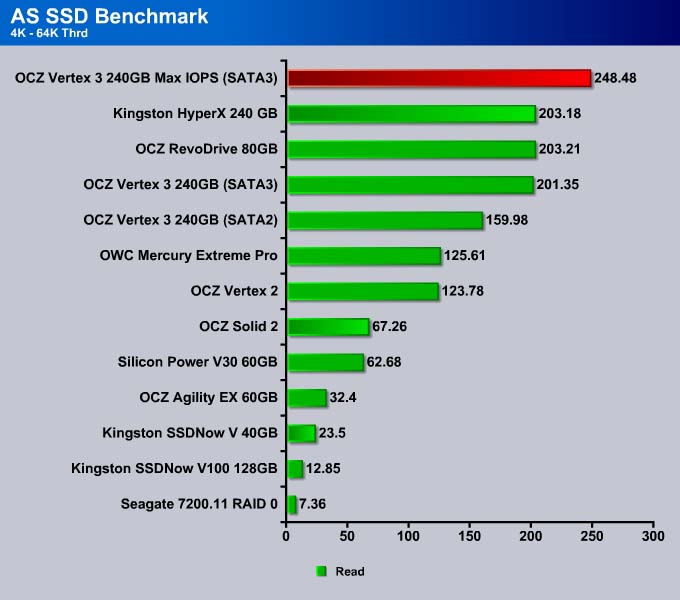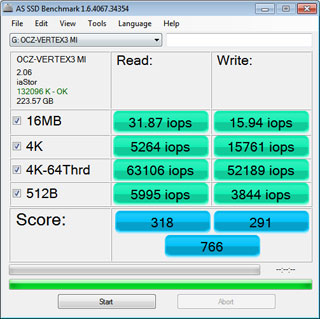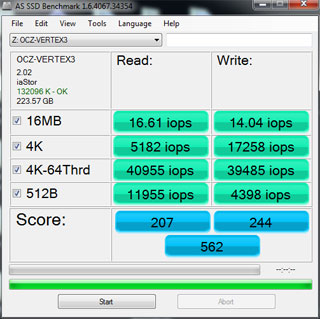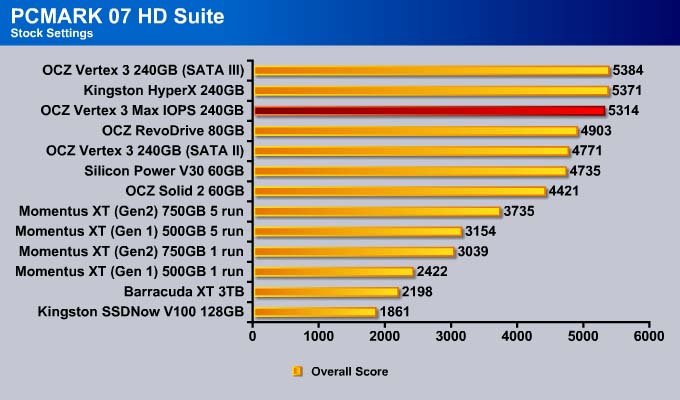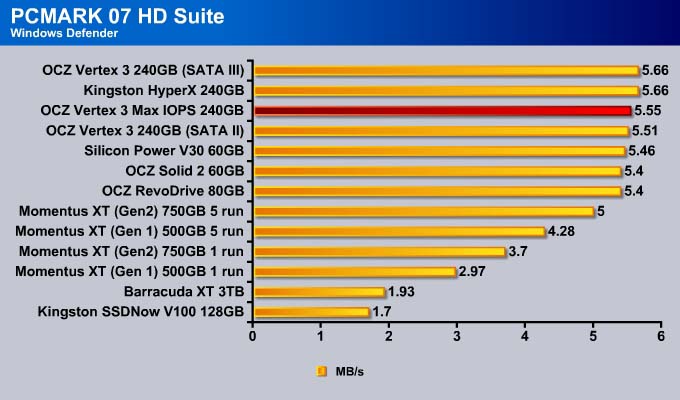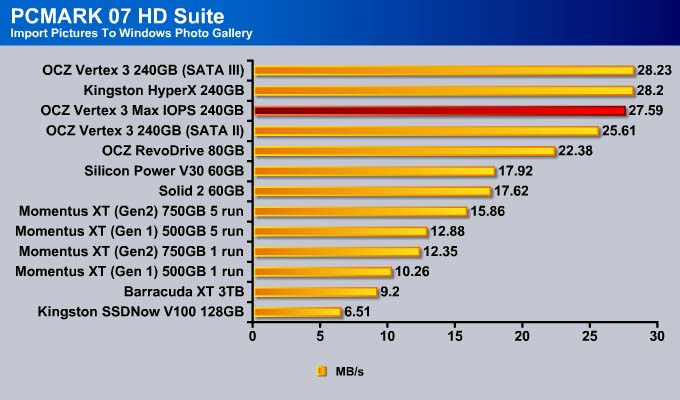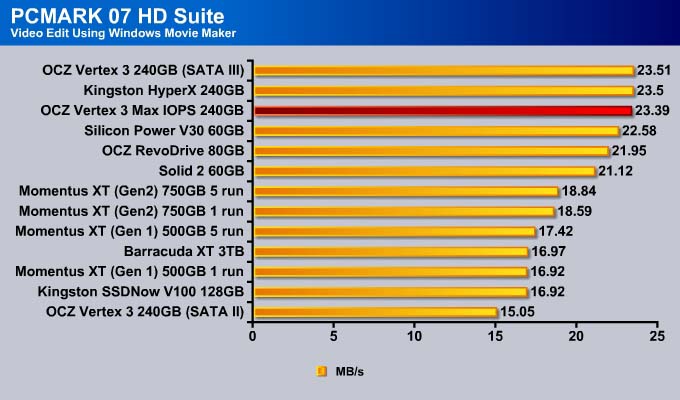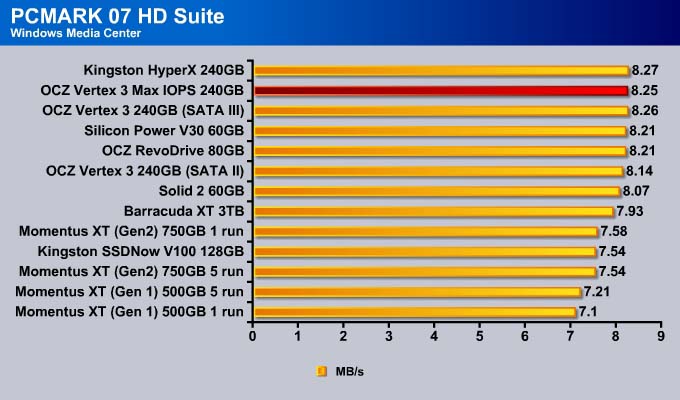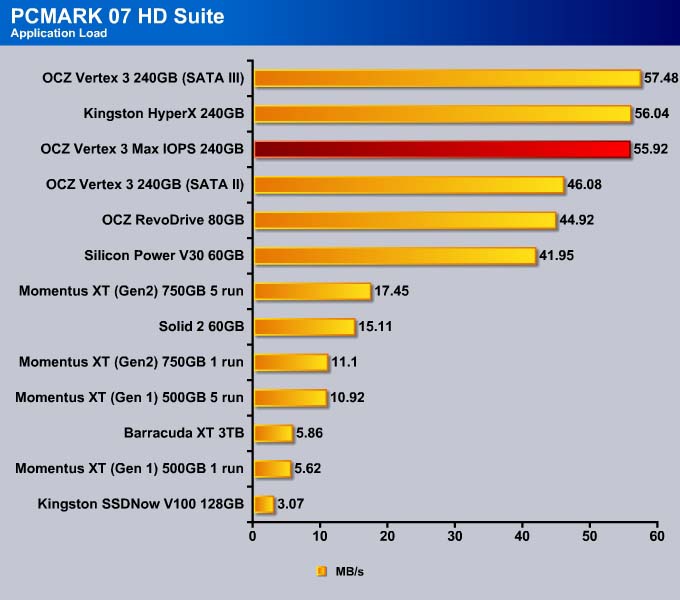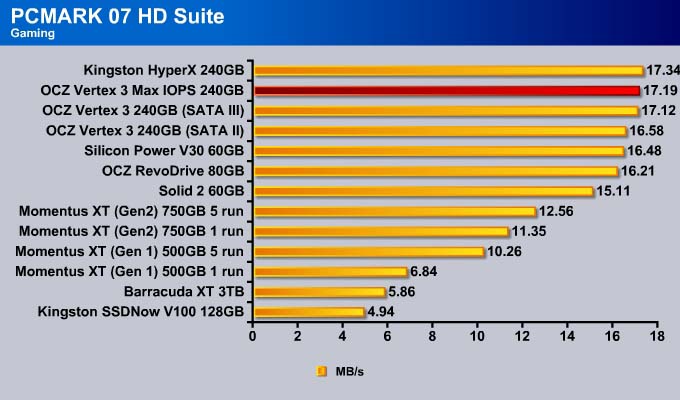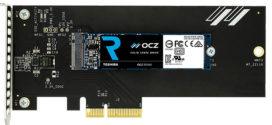The Vertex 3 MAX IOPS with 34nm NAND offers higher IOPS than the Vertex 3. We put the drive against the 25nm NAND Vertex 3 to see the performance difference between the two drives.
INTRODUCTION
Advancement in the computer industry is very fast paced. As technology advances, things often get smaller and faster. Over the last couple of years, we have seen SSDs moving in a very rapid pace so the controllers matured to take full advantage of SATA 6Gbps interface and NAND die shrink from 32/34 nm to 25nm. The NAND’s die shrink allows more storage capacity per NAND device, doubling the maximum NAND capacity to 8GB. This would allow SSD manufacturers to produce SSDs of the same capacity with less NAND devices, and also to make larger storage capacity drives.
However, the transition to 25nm NAND is not all trouble-free. While the die shrink allows larger storage capacity, it also leads to a reduction in the durability as the number of write cycles has been reduced. SSDs have a very finite number of write/programmable cycles. With the die-shrink, the number of write cycles is also reduced. 34nm NAND has about 5000 write cycles, whereas 25nm NAND has only 3000.
Even considering the reduction in write cycles, 3000 should still be enough for average users and we do not expect most 25nm SSDs to fail during their lifespan. Still, for those who need absolutely the most reliable data storage and often are write and erase tons of data on their SSD, a 25nm drive means a possibility of an earlier failure date which may not be acceptable.
This is why OCZ has decided to release the Vertex 3 MAX IOPS that bundled the latest SandForce 2281 controller with 32nm NAND as opposed to the 25nm NAND that was used with the Vertex 3. Retailed at about $20-$30 higher than the Vertex 3, the extra bit of money yields a drive that has a greater durability. Just how much of a performance difference between these two drives? This is the question that we want to answer today.
OCZ VERTEX 3 MAX IOPS
OCZ packages the drive in a padded cutout of the SSD to secure it during shipping. The drive is shipped with the 3.5” bay adapter on the outside which can act as a protective shield during shipping.
The drive comes with a bag of screws and the 3.5” drive adapter to allow for installation inside a 3.5″ bay.
OCZ continues to use the black color scheme on their performance SSDs.
There are two storage capacities available: 120GB and 240GB. Both drives features the same maximum sequential read and write speed of 550 MB/s and 500 MB/s, respectively. However, the 120GB drive has lower random 4K read IOPS of 35,000 while the 240 GB drive is able to have 20,000 IOPS more. The 4K random write on the 120GB drive is 10,000 higher than the 240 GB drive.
Other than these, both drives support the SATA 6 Gbps interface like the Vertex 3 and carry the 3 year warranty.
120GB: VTX3MI-25SAT3-120G:
- Max Read: up to 550MB/s
- Max Write: up to 500MB/s
- Random Read 4KB: 35,000 IOPS
- Random Write 4KB: 75,000 IOPS
- Maximum 4K Random Write: 85,000 IOPS
240GB: VTX3MI-25SAT3-240G
- Max Read: up to 550MB/s
- Max Write: up to 500MB/s
- Random Read 4KB: 55,000 IOPS
- Random Write 4KB: 65,000 IOPS
- Maximum 4K Random Write: 85,000 IOPS
*Max performance achieved using Native SATA 6Gbps chipset. Please refer to product sheet for additional performance metrics
FEATURES
- Available in 120GB and 240GB Capacities
- MLC NAND Flash
- Interface: SATA 6Gbps / Backwards Compatible 3Gbps
- Native TRIM support
- Seek Time: .1ms
- Slim 2.5″ Design
- 99.8 x 69.63 x 9.3mm
- Lightweight: 77g
- Operating Temp: 0°C ~ 70°C
- Ambient Temp: 0°C ~ 55°C
- Storage Temp: -45°C ~ 85°C
- Low Power Consumption: 3W Active, 1.65W Idle
- Shock Resistant up to 1500G
- RAID Support
- Included 3.5″ Desktop adapter bracket
- Compatible with Windows 7, Vista, XP 32-bit/64-bit, Mac OSX
- MTBF: 2 million hours
- 3-Year Warranty
What’s different from the Vertex 3?
Both Vertex 3 and the Vertex 3 MAX IOPS use same SandForce SF-2281 controller. The difference between the two drives is the type of NAND flash used. While the Vertex 3 uses Intel 25nm ONFI 2.0 NAND, the MAX IOPS uses 32nm Toshiba Toggle NAND.
Because 32nm NAND has a maximum capacity of 4GB per die as opposed to 8GB for the 25nm, in order to fit the same storage capacity, the MAX IOPS would need twice as many NAND dies. The Vertex 3 MAX IOPS features 16 multi-layer cell Toshiba TH58TAG7D2FBAS9 Toggle-NAND Flash modules. We see eight of them on one side with the SF-2281 controller, and there are eight more on the opposite side of the PCB.
| Number of NAND Channel | Number of NAND Packages | Number of die per Package | Total Number of die | |
| OCZ VERTEX 3 240GB | 8 | 16 | 2 | 32 |
| OCZ VERTEX 3 MAX IOPS 240 GB | 8 | 16 | 4 | 64 |
When a write/read command is issued, data are not being accessed directly from the NAND. Rather, the way data are handled between the external device and NAND in a multi-step process where a series of sequential-accessed command and data registers are involved. Thus, when multiple NAND devices/dies are connected to a single channel, data are being interleaved. While only a single NAND chip can be accessed at a given time, the other NANDs on the same channel can be doing internal operation. So when a read command is issued to a NAND die, the internal operation will go out and seek the data. While it is seeking the data internally, a separate command can be issued to another NAND on the same channel. This interleaving of data will increase the performance of an SSD.
For the Vertex 3 MAX IOPS, this works out to be an 8-way interleaving while the Vertex 3 has a 4-way interleaving as there are only 32 NAND dies used. Keep in mind that interleaving can only enhance the performance to certain extent, so the performance enhancement may not always be directly proportional to the number of dies.
| Vertex 3 240 GB | Vertex 3 MAX IOPS 240GB | |
| Sustained Sequential Read (MB/s) | 550 | 550 |
| Sustained Sequential Write (MB/s) | 520 | 500 |
| MTBF (hours) | 2,000,000 | 2,000,000 |
| 4K Random Read (IOPS) | 40,000 (155 MB/s) | 55,000 (215 (MB/s) |
| 4K Random Write (IOPS) | 60,000 (235 MB/s) | 65,000 (250 MB/s) |
| Max 4K Random Write (IOPS) | 85,000 (330 MB/s) | 85,000 (330 MB/s) |
| AS SSD Sequential Read (MB/s) | 510 | 510 |
| AS SSD Sequential Write (MB/s) | 280 | 240 |
Looking at the official specifications we can see that the Vertex 3 MAX IOPS has the same sequential sustained read of 550MB/s as the Vertex 3 but the sustained sequential write is a tad slower at 500MB/s as opposed to 520 MB/s that is found on the Vertex 3. However, the 4K random read and random write for the Vertex 3 MAX IOPS is higher than the Vertex 3. The greater number of IOPS for the random read and write could make the Vertex 3 MAX IOPS a faster drive and feel snappier than the Vertex 3. This is of course assuming that the hard drive is the slowest component inside a system. In practice, since SATA III SSDs are so fast, it would be difficult to perceive the difference between the two drives.
TESTING & METHODOLOGY
To test the OCZ Vertex 3 MAX IOPS, we cloned our test rig drive to the SSD. It is the same test drive we’ve been using on all of our drive testing and is nothing more than a clean Windows load with all the drive testing software installed, as well as all the current drivers and patches for the OS. It’s the equivalent of doing a fresh load of Vista from the disc but takes a lot less time and ensures that every drive tested uses exactly the same OS load and drivers. Nothing that may effect the outcome of the testing procedure can creep in. We ran all of the tests a total of 3 times and averaged those results. The Average of the three results are presented here. In the case of a pictorial benchmark we ran the bench 3 times and picked the median result. As with most SSD testing differences from run to run are minimal and the median result is a good indication of what you can expect from the drive.
We ran our usual battery of tests on the drive, and used it as the primary boot drive during testing. All of the drives tested were used as the primary boot drive during testing. That’s a more realistic test than strapping the drive in and testing it with a bare format or as a non-boot drive and it represents real life transfer rates, much like you can expect when you install and operate the drive in your own system. Each test was performed 3 times and the average of the 3 test run is reported here.
Test Setup
| Test Setup | |
| Case Type | None |
| CPU | Intel Core i5-2500K |
| Motherboard | Asus P8Z68-V Pro |
| RAM | Kingston HyperX 1600MHz |
| CPU Cooler | Prolimatech Megahalem |
| Storage Drives | OCZ Vertex 3 MAX IOPS 240GB Silicon Power Velox V30 60GB OCZ Vertex 3 240GB OCZ RevoDrive 80GB OCZ Solid 2 60GB Kingston SSDNow V+ 128GB MLC OCZ Agility EX 60GB (SLC) Kingston SSDNow V 40GB (MLC) Kingston SSDNow V+ 128GB (MLC) G.Skill Titan 256 GB SSD (FM-25S2S-256GBT1) (MLC) Patriot 128GB Warp SSD (MLC) Intel 80 GB SSD X25-M G.Skill 64GB SSD (FM-25S25-64GB) (MLC) 2 WD VelociRaptor’s 300GB (In single and RAID 0) WD 160 GB SATA 2 Maxtor 160 GB SATA 2 WD & Maxtor in RAID 0 |
| Optical | None |
| GPU | Gigabyte GTX 260 OC |
| Case Fans | 120mm Fan cooling the mosfet CPU area |
| Docking Stations | None |
| Testing PSU | Cooler Master UCP 900W |
| Legacy | None |
| Mouse | Microsoft Intellimouse |
| Keyboard | Logitech Keyboard |
| Gaming Ear Buds | None |
| Speakers | None |
Test Suite
| Benchmarks |
| ATTO |
| CrystalDiskMark |
| AS SSD Benchmark |
| PCMark Vantage |
| PCMark 07 |
ATTO
Storage manufacturers often use ATTO to rate their drives. ATTO is designed primarily for mechanical drives, not for the SSDs. While it may not always tell the whole story, we include it just to give an idea on how the SSD stacks up against other drives. Also, it is worth re-testing to confirm the veracity of the manufacturer’s claim.
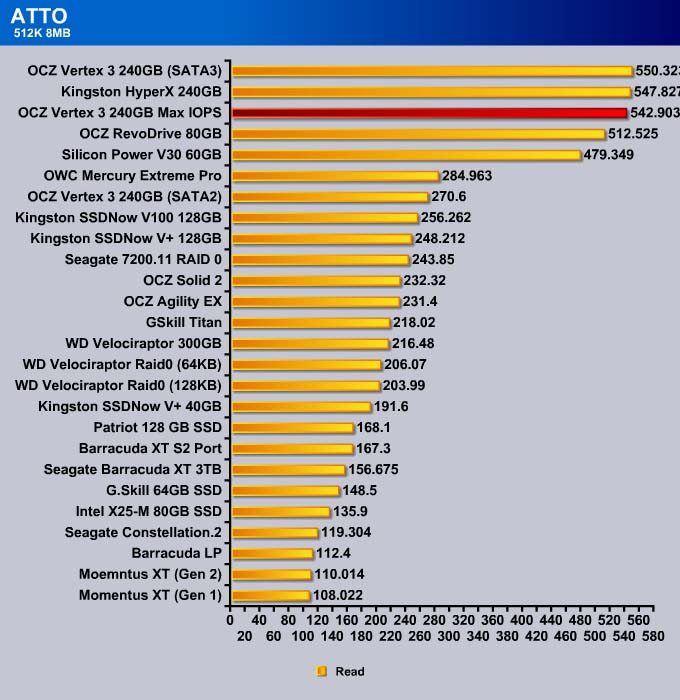
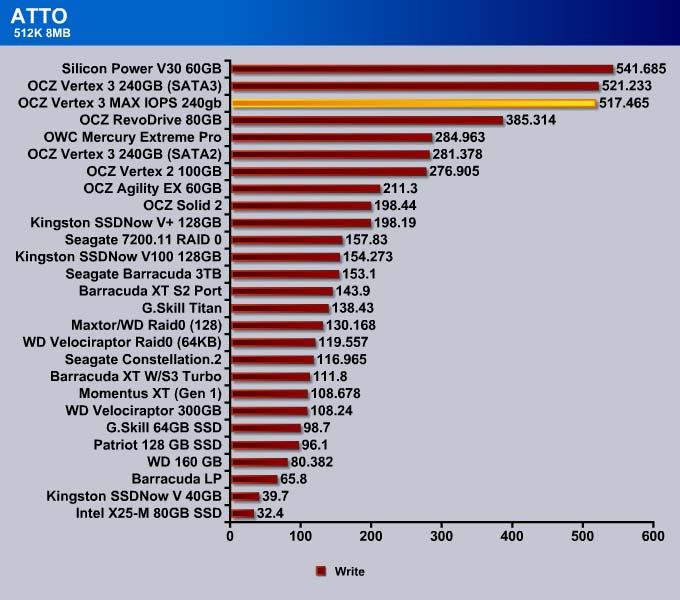
Vertex 3 MAX IOPS (left) Vertex 3 (right)
CrystalDisKMark
4K
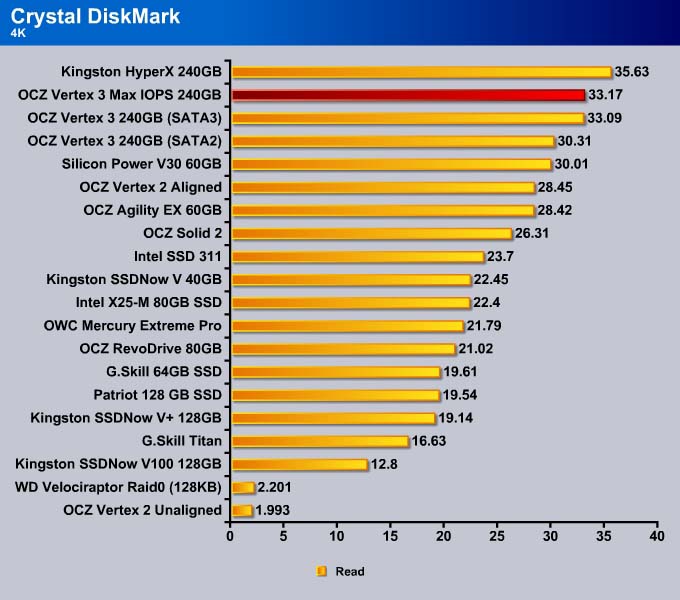
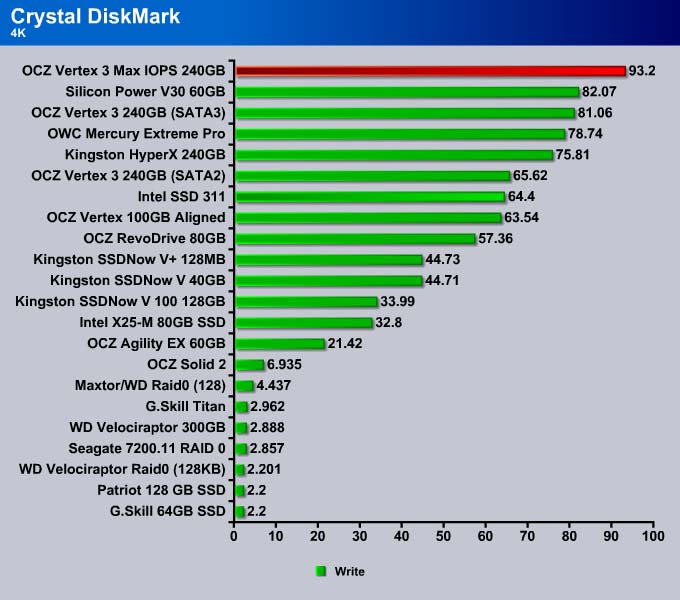
We can see the 4K write for the drive is 12MB/s higher than the Vertex 3. That’s a 15% performance increase with the MAX IOPS drive.
While most people will not use more than a few queue depth, we include 32 queue depth to show the drive’s performance under heavy multiple use environment. Here we can see the Vertex 3 MAX IOPS has a 20% higher performance in read than the Vertex 3. However, the write performance is about 5% lower than the Vertex 3.
512K
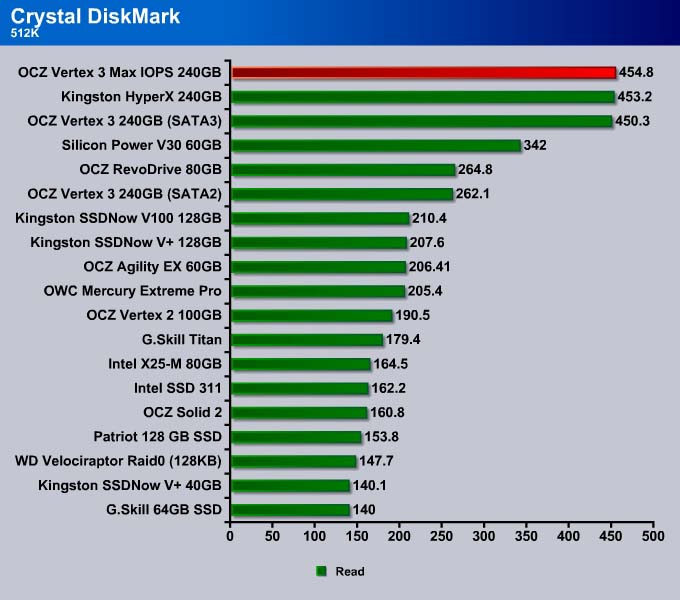
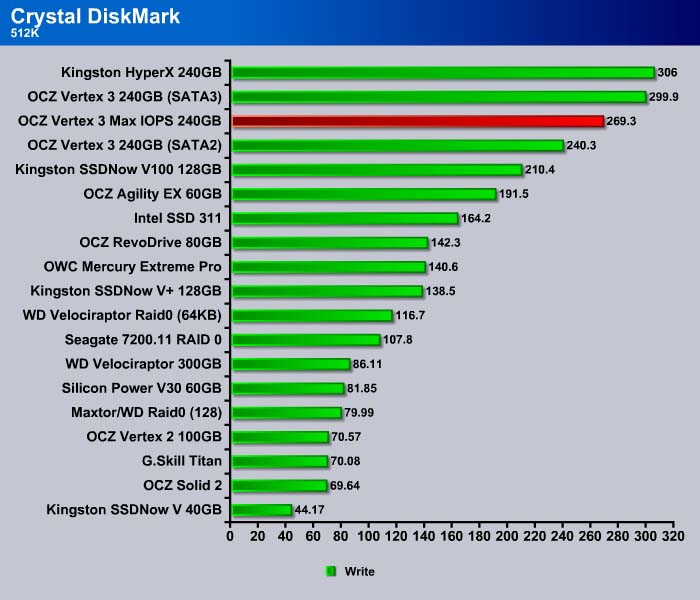
However, 512K write speed for the drive is a tad slower.
Sequential
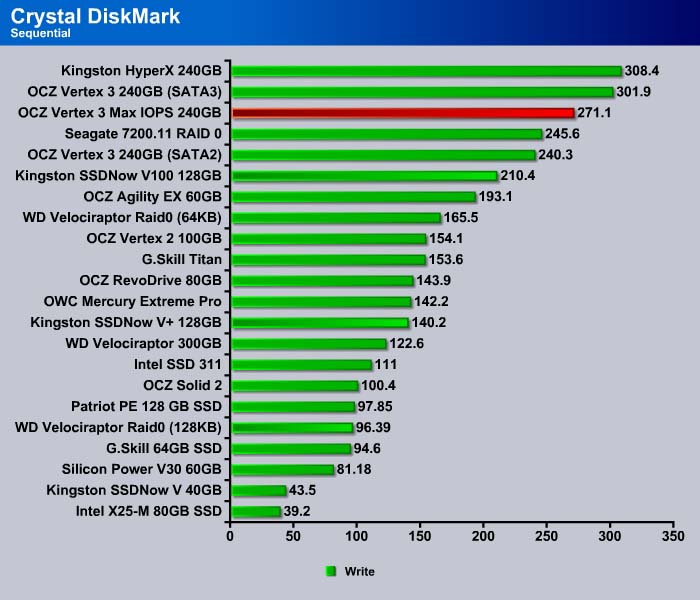
Like what we have seen with the 512K, the sequential read for the MAX IOPS is comparable to other SandForce drives but the sequential write is slower than the 25nm drives.
AS SSD Benchmark
4K
AS SSD tests the drive’s ability at handling incompressible data so the performance of the Vertex 3 MAX IOPS is comparable to the other SandForce’s drive. As the drive features real-time compression, it often does not do too well with incompressible data. Users who often deal with compressed data (mp3, avi, etc) should not choose SandForce-based drives.
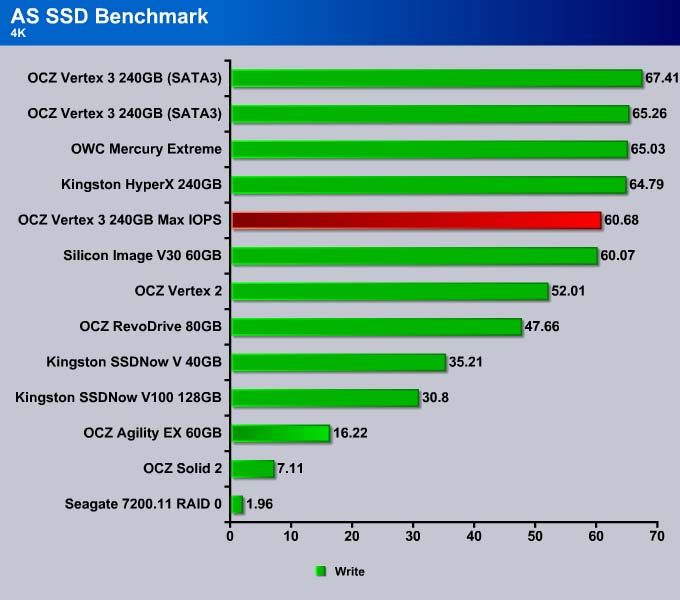
When comes to write, the drive once again is is about 7% slower than the Vertex 3.
4K-64K Thread
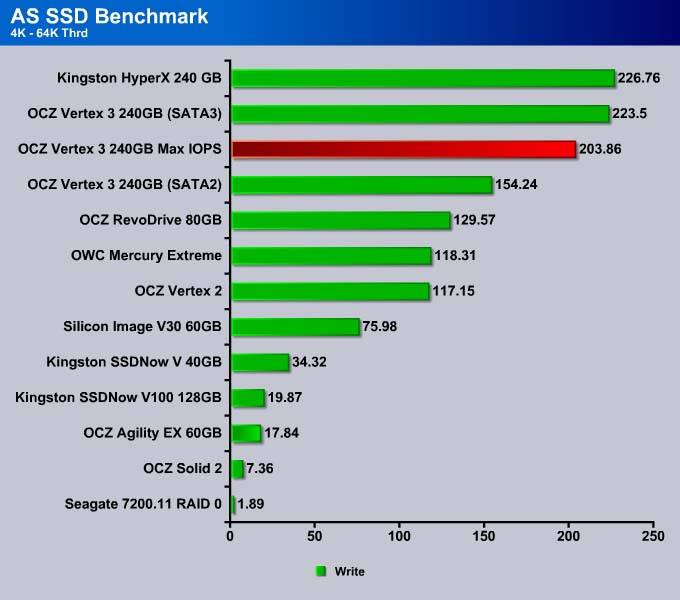
Sequential
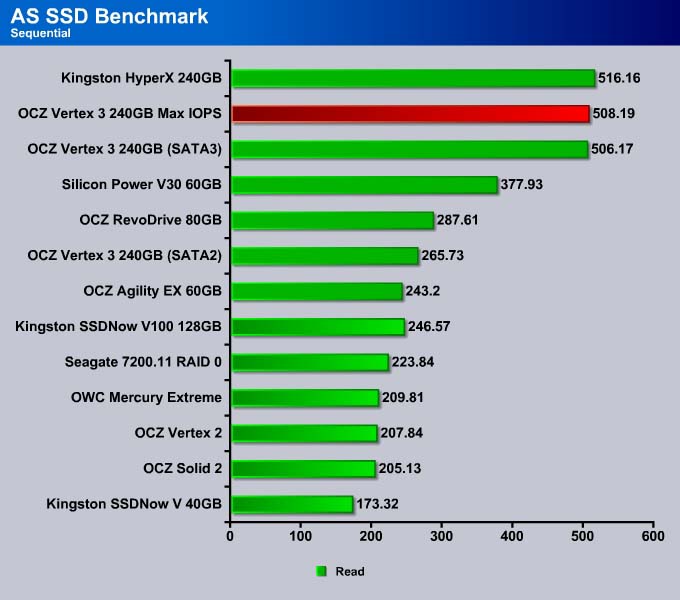
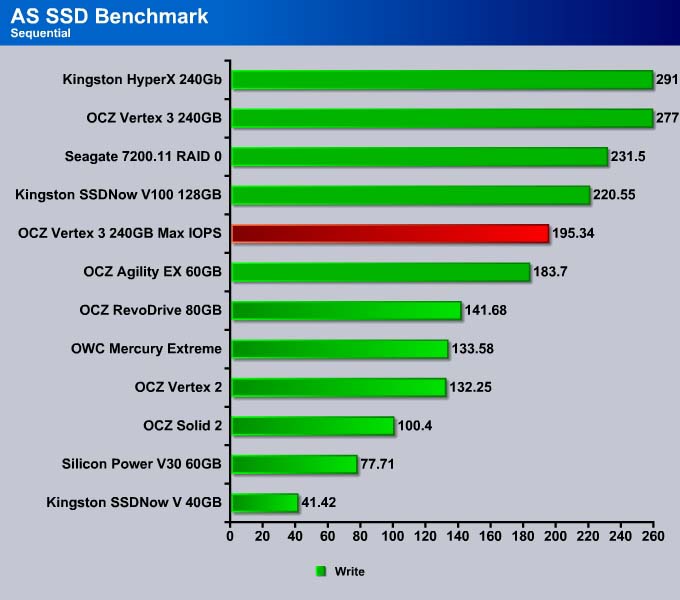
As expected, the sequential read for the incompressible data is what we expected to see.
IOPS
Vertex 3 Max IOPS (left) and Vertex 3 (right)
The performance of an SSD is not always dependent on raw transfer speeds (MB/s). A drive with higher number of Input/Output Operations Per Second (IOPS) often performs better despite a lower MB/s. A drive with high IOPS will make the system feel snappier. The number that is particularly interesting here is the 4K read and write as that is how a system will boot faster and applications will launch faster.
We can see that the Vertex 3 MAX IOPS has a slightly higher IOPS than the Vertex 3 in the read but slower in the write with single thread operation However, as the thread counts increase, we can see the MAX IOPS is able to offer 54% higher throughput in read and 32% in write.
The high IOPS is how a drive can make a system feel faster. Here we can also see the OCZ Vertex 3 MAX IOPS hits 63K read and 52K write IOPS for the 4K-64 thread. The drive is nowhere close to the 85,000 IOPS that the specification states.
PC MARK 7
We use PC Mark 7 HD Suite to assess a drive’s performance under commonly used tasks.
If we use PCMark 07 as our sole performance assessment, we can see the MAX IOPS is not much slower than the Vertex 3. There is only about 1% difference between the two.
Looking at the individual test scenarios, we can see that all SandForce based drives at 240GB perform relatively comparable to each other. The differences are less than 1% so it would not be anything that average users would be able to tell.
Importing picture involves relatively small file size so the Vertex 3 has a slightly edge over the MAX IOPS.
Video Editing is primarily dealing with incompressible data so all SandForce based SSD’s perform relatively close to each other.
The Application test favors the Vertex 3 slightly.
CONCLUSION
Do not think that the Vertex 3 MAX IOPS is a faster drive than the Vertex 3. If we look at the at the performance in PCMark Vantage, we can see that the difference in the performance between the Vertex 3 and Vertex 3 MAX IOPS is very slim, and the Vertex 3 often comes a tad ahead of the MAX IOPS. Most desktop applications are not executing enough input/output operations to take the advantage of the MAX IOPS’s ability. We would only see the MAX IOPS drive shine if we were to really stress it under high queue depth. The drive has about a 15-20% better read result but it is also about 5% slower in write. So, for most part, the Vertex 3 MAX IOPS is going to give users about same performance as the Vertex 3.
The Vertex 3 MAX IOPS is specifically tailored toward those who need a very high IOPS read performance. Furthermore, due to the use of 32nm NAND instead of 25nm, it also has greater durability than the Vertex 3. For average desktop user, the Vertex 3 would probably be our drive of choice. We do not think that the lower write/programmable cycle would be a huge issue for most users during the lifespan of the drive.
The good news is that OCZ only charges $30 more for the MAX IOPS, so it is a small price to pay for a more durable drive.
| OUR VERDICT: OCZ Vertex 3 MAX IOPS | ||||||||||||||||||
|
||||||||||||||||||
| Summary: The OCZ Vertex 3 MAX IOPS is a great drive, with roughly the same performance as the OCZ Vertex 3. However, it offers more durability and can output a lot more IOPS for users who need that kind of performance. For its quality and features, it earns the Bjorn3D Silver Bear Award. |
 Bjorn3D.com Bjorn3d.com – Satisfying Your Daily Tech Cravings Since 1996
Bjorn3D.com Bjorn3d.com – Satisfying Your Daily Tech Cravings Since 1996








